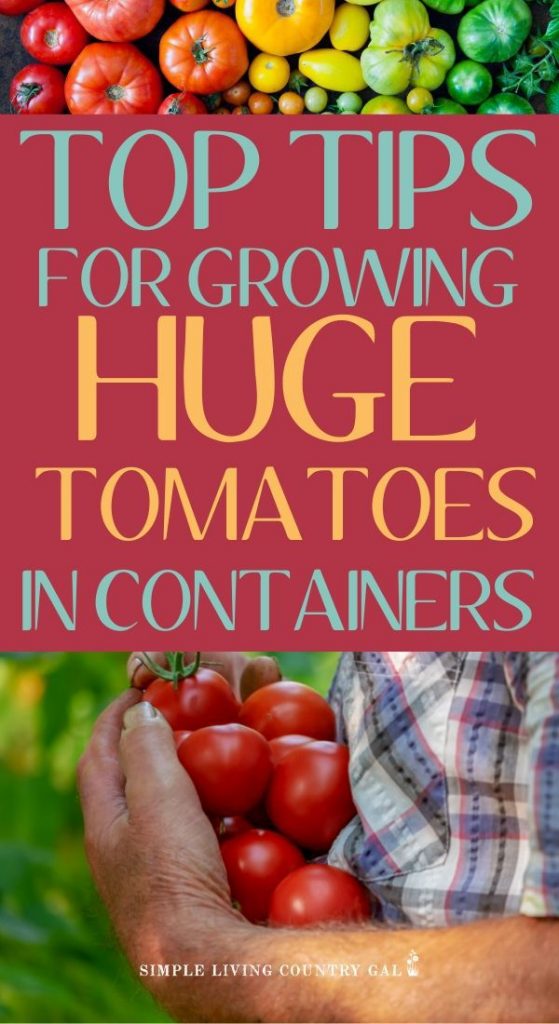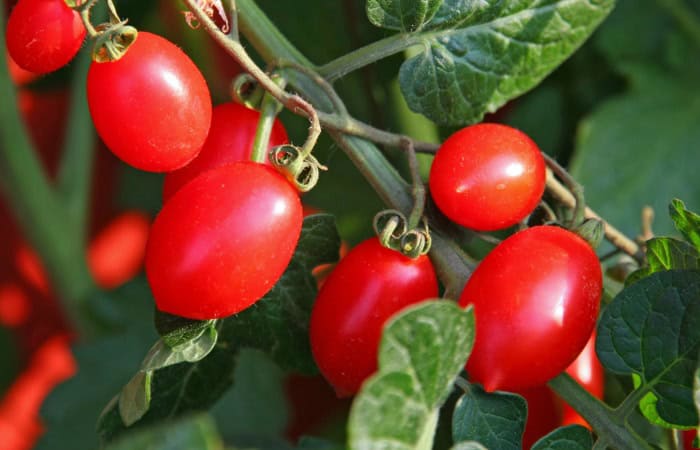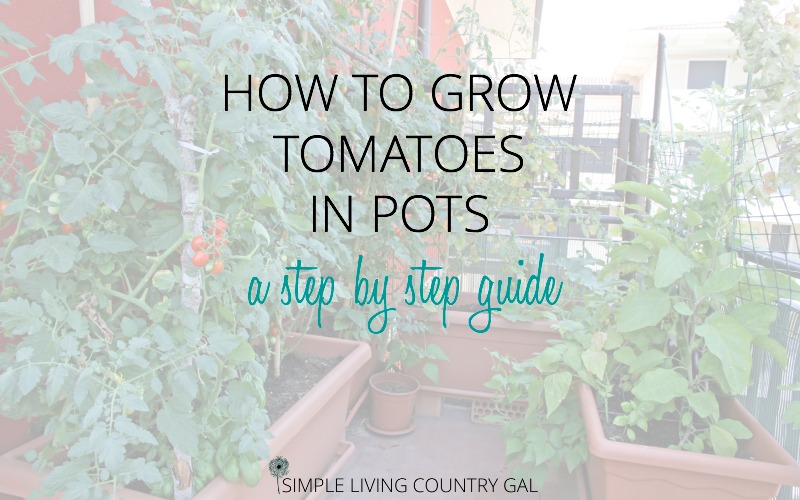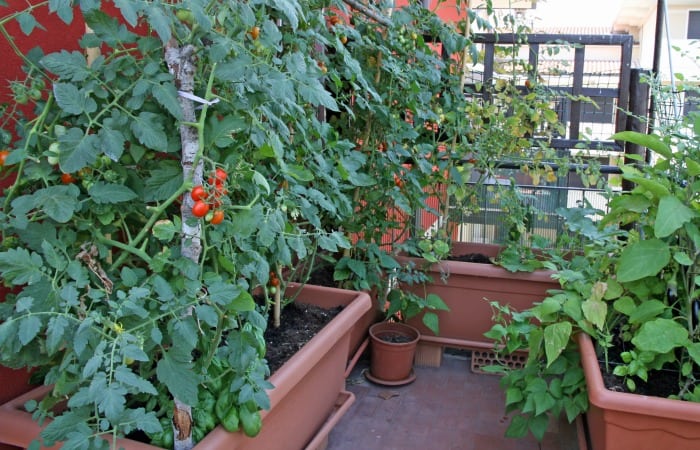How To Grow Tomatoes In Pots – A Step-By-Step Guide
This article will help you learn how to grow tomatoes in pots on your back porch. The easy way to garden when you don’t have the property to create an entire garden.
Another great gardening 101 resource you can turn to year after year.

One of my favorite parts of homesteading is getting my hands dirty and the ability to grow enough food for my entire family. To take a seed from a little paper packet, plant it in some ground, and a few months later I have a bountiful harvest is something I look forward to every year.
Unfortunately, the last few years have not been good for my garden and this year I am forced to do something drastic.
My soil has become invaded with just about every garden pest in our area. And to add insult to injury we also got hit with some pretty nasty diseases as well. I have tried to fix things on my own but I realize now it is going to take a bit longer than just one offseason to fix things.
This year instead of planting in my garden out in our back yard I am moving things on up to the house. Yes, this year I am going to have an entire vegetable garden out outside my backdoor. A patio garden and I am pretty excited to see how it goes.
I have always grown a few things on my patio. Flowers, herbs, and every now a then maybe even a planter of lettuce. My full garden, however, is usually quite a ways from the house so it is always nice to have a few things close by for meals.
This year, however, I am pulling out all the stops.
I plan to grow my entire garden up by the house using any container I can get my hands on. This will, in turn, allow my garden to sit vacant giving it time to heal. I will also be setting my chickens loose in the garden so they can dig up the soil. This will do two things. One – it will allow them to get in and begin eating away at any bugs and larvae that are in the soil. And two – it will also allow them to fertilize the soil at the same time.
Giving it a good dose of chicken compost. Because of the state of the garden, it was suggested to me by a local master gardener to let my garden sit dormant for 1-3 growing seasons (yes, you read that right). And because the thought of having no fresh produce all summer long was giving me an anxiety attack, I was desperate for a plan B.
SLCG PRO TIP: When you let a garden sit dormant this means you are planting nothing in it all growing season. This gives any pests that have laid eggs in the soil no plants to feast on. By doing this for a few years you will kill off pests without having to rely heavily on chemicals to remove them.
I spent the last several months researching all I can about growing vegetables in containers.
I just assumed all plants were created equal and the methods I used to grow my Marigolds would work just as well with my peppers and tomatoes. Needless to say, what I found was just the opposite. There are different rules for different vegetables. And in this post, we are going to cover, tomatoes.
Update: It has been a few years since I wrote this article, and I am happy to say that I am still using my patio for my garden. Not because my other garden never got a chance to heal as I had hoped but because I like to have my garden so close to my kitchen door.
I have updated this article with what I have learned over the last few years. I hope this guide will help you to grow not only tomatoes but your entire garden in a variety of containers nice and close to your kitchen door.
This guide is mainly on how to grow tomatoes, but I have links to many other veggies that you can check out. Start out small and work your way up adding in more and more varieties.
How to Grow Tomatoes in Pots – A Few Things to Remember
When growing your garden in containers there are really no rules when it comes to the style of container. You can pretty much use anything you have as long as you follow a few guidelines.
- Make sure you have ample drainage. – This means you will need to have a way for any excess water to escape so it does not pool at the bottom of the container. This can rot the root system and damage the plant producing weak fruit. To fix this you can drill a few holes in the bottom or using a hammer and nail, simply “pound” in a few instead.
- Make sure your plants have enough room to grow. – The key to strong and healthy plants is allowing enough room for a sturdy root system to develop and grow. For tomatoes, you will want at least a 5-gallon container. This should be enough for a strong toot system to develop and, in turn, give you a large and healthy plant.
- Make sure your containers are clean. – For any container you plan to use for growing produce, you will need to give it a thorough washing using soap and water being sure to rinse thoroughly. You can also allow it to dry in the sun using its natural abilities to sterilize.
- Make sure you choose a sunny location – Choose a spot that gets at least 6 hours of sun. You can group your plants together for easier care but do not let the plants touch. I like to use outdoor carts with wheels to make moving my plants much easier.
- Make sure you are close to a hose or other water source. – Potted tomato plants require a steady amount of water so if possible locate your planters close to a water supply or at least close enough that a hose will reach. Remember, with containers, you will be watering much more frequently than in an in-ground garden. Be sure to set things up so this daily chore is a bit easier for you to do.
Plenty of room and plenty of drainage are your first steps when you are looking to grow tomatoes in pots or containers. As long as you have those two things right, you are well on your way to a summer full of BLT’s and homemade sauce!
Container Gardening Resources:
How To Grow Tomatoes In Pots – Step-by-Step
Growing Cherry Tomatoes in Containers
When folks think of how to grow tomatoes in pots they immediately go to cherry tomatoes and rightfully so. This is the perfect plant to grow close to the house so you can grab a yummy snack all summer long. To ensure you get the most out of this wonderful plant let’s get things set up for a healthy plant.

Step #1 Pot size – You will want to look for a container that will hold 5 gallons and is around 14-20 inches in diameter. A bucket will work well for this and if the handle is still attached, it will make it easier to move it around if needed.
Remember, by having a large enough container you will better help your plant to develop a large and healthy root system.
Don’t forget to add in a few drainage holes in the bottom of the container. You can do this with a drill or a hammer and nail.
Step #2 Planting – When planting cherry tomato plants in containers, keep it to one plant per pot. Don’t be tempted to put more than one plant into a pot. Overcrowding can lead to poor air circulation which can lead to diseases such as early blight. Remember, your goal is to allow enough room for the roots. Tomatoes are used to being in the ground and having enough room to stretch out and flourish, your goal with containers is to replicate that room as much as possible. Keep the roots happy and healthy and you will grow a happy and healthy supply of tomatoes.
Step #3 Planting – When planting any variety of tomato, be sure to use good quality soil and compost mixture. Fill your container 3/4 of the way full with soil. Transplant your cherry tomato plant in the center being sure to loosen up the root base to better encourage growth. Add in more soil leaving about 1 inch of space from the top of the container. As the soil settles you will want to add in a bit more.
Once flowers start to appear, top dress around the base of the plant with compost. As you water the nutrients from the newly added compost will slowly work its way down to the plant’s roots making absorption easier.
Step#3 Support – Cherry tomato plants can get full of small tomatoes and even though they are small they can become quite heavy as more and more growth. Usually, a center stake will give your plant enough support. Using gardening twine tie a loop around the center stem and the stake. Be sure to give enough room for future growth.
Step#4 Water – Adding enough water is the secret sauce to a healthy harvest. One of the drawbacks of growing your tomatoes in pots is you will need to water more often. For vegetables, it is always best to water in the mornings. This will give the sun time to dry off the leaves as the day heats up. When watering in the evening the leaves remain wet longer opening them up to fungus and other diseases. If this is your first time gardening in containers I suggest you set a reminder on your phone for the same time each morning. I know it sounds silly, but miss just one day and the sun can quickly dry out your plant and possibly damage your tomatoes at the same time.
Growing Full-sized Tomatoes in Containers
Yes, it is possible to grow full-sized tomato plants in containers! How cool is that? But before we dive in deeper we need to go over a few terms. There are actually two types of tomato plants, Determinate and Indeterminate.
Determinate tomato plants reach a certain plant height and then stop growing. The majority of their fruit matures within a month or two and appears at the ends of the branches.
These tomato plants need to be supported because of the weight of the tomatoes. You can do this with a simple tomato cage and are a favorite of canners since all the tomatoes tend to ripen at once.
Indeterminate tomato plants are vine-like plants. These types of tomato plants continue to grow and produce fruit all season long. It is not unusual to have indeterminate plants reaching 15 feet or even more so a support of at least 5 feet is a must. For this reason, a larger tomato cage may be needed. The biggest advantage to these plants is you will get fruit all season long which is perfect for eating and enjoying.
When choosing a plant for your pots it is best to stick with a bush-like Determinate tomato plant. This will keep the plant closer to the pot giving it more stability.
Step#1 Pot size – The size of the container is important when growing tomatoes because, as stated above, you will want to make sure your plants have enough room to establish a sturdy root system. The health of your plant all comes from the roots and the healthier and stronger they are the better your plant and your harvest will be.
Choose a pot size that is at least 18-inches in diameter. A good choice is a 5 or even 10-gallon bucket that has a few holes in the bottom for drainage.
Step#2 Drainage – As mentioned above be sure to drill holes in your containers for ample drainage. This will prevent water from puddling at the base of the roots something that can damage or even rot the entire root system.
I like to put in a few rocks at the bottom of the container to be sure the roots are kept up and out of any standing water. Not many is needed, just a few handfuls that will be enough for a single layer.
Remember the bigger the container the better your plants will grow but those big containers will also be incredibly heavy. I use bases with wheels to help me to move things when needed. This is incredibly useful if you get a heavy storm with high winds. Something that can damage tomato plants if given a chance.
Step#3 Support – Add your support such as a tomato cage to the container right away. Doing so later risks disturbing the root system and/or damaging the plant. As the plant grows you will need to guide the branches through the cage so it is well supported as the fruit begins to form. Unlike cherry tomatoes, full-sized tomatoes are quite heavy and require a full tomato cage to help support the weight of the heavy fruit.
Step#4 Planting – Be sure to dig a hole deep enough that it will cover ⅔ of the plant’s stem. This will help to encourage more root growth and result in a more sturdy plant. I tend to forget that the health of the plant is all about the roots. The more care you take now, the better your harvest will be later.
Step#5 Mulch – Even though you are using pots it is still important to include a good layer of mulch. For this reason, you want to make sure you leave a good 1-2 inches of space below the rim of the pot. Using mulch will keep your soil moist longer so make sure to replace with fresh mulch as the mulch compresses during the growing season. Bark, straw, leaves, or shredded newspapers are all good options for mulch.

Read: Why You Should Mulch Your Garden
Step#6 Soil – Make sure to use the best soil possible for the best plants. This is an important step so no scrimping here. Choose a light and fluffy potting soil that will not compact down. Please note when using a fluffy soil that it may rest down and you will want to add more soil later on.
Step#7 Water – Adding enough water is the secret sauce to a healthy harvest. One of the drawbacks of growing your tomatoes in pots is you will need to water more often.
Unfortunately, there is a fine line between enough water and too much. To be sure you are giving the right amount, I like to apply the high-tech finger test. Simply stick your finger down into the soil and if the top 1 inch or so is dry, it’s time to give your plant a drink.
A good rule of thumb to follow when watering tomatoes in pots is to give a good water weekly and light water every day. Of course, the amount and frequency of your water will all depend on the amount of sun your plants are getting. By checking the condition of the soil every time you water you will be better able to gauge just how much you need.
Bottom line. Watering is the key to a healthy strong and abundant tomato plant. You want to keep the soil in your pots consistently moist – not wet, but damp.
Final rules to remember
Tip #1. When growing tomatoes in pots watch for any heavy winds. This is where you will want containers that can be moved if needed. If you see strong winds are in the forecast move your plants closer to the house to help shield them a bit.
Tip #2. Container gardens are still susceptible to bugs and diseases. To catch things early before they get out of hand, keep an eye on the leaves of your plant. If you see yellowing, spotting, or other things that are out of the ordinary you will want to do a bit of investigating to see what’s going on. As with any illness, if you can catch it early on, you can most likely stop it before it becomes an issue.
Tip #3. Watch for weakness with your tomatoes. If you see your plant struggling under the weight of too many tomatoes you can either add in another stake or remove some of the fruits before anything breaks.
More often than not your plants can handle the weight of the fruits, but in some cases, you may need to add in more support. Tomato plant stakes are a great way to do just that and can be used in addition to tomato cages.
Tip #4. Fertilize if needed. Again, even though your plants are in containers the same rules apply for fertilizing. If your plant needs additional help, go ahead and add a fertilizer made specifically for tomatoes to the soil. You can do this with another dose of compost, mixing up a batch of compost tea, or purchasing an organic fertilizer.
READ: How to Compost in Your Own Backyard
READ: How to Compost Your Kitchen Scraps
Tip #5. Watch the moisture of your soil. Things tend to dry up more quickly in containers and that means you will need to monitor the soil daily. This is easy to do and you can incorporate it into your morning chore routine.
As you go out to check your containers poke your finger into the soil of each container. You are looking for damp but not overly dry or wet. If the soil is damp you can add a little more water to keep it consistent as the heat of the day gets more intense.
Armed with this simple guide on how to grow tomatoes in pots, you too can have a delicious garden right outside your kitchen door.


